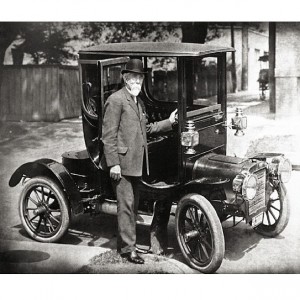As most classic car enthusiasts enjoy studying the history of the automobile and the people who built them, the name Henry Leland should be a lot more recognizable today than it probably is. This becomes apparent when one considers that Henry Leland founded both of the two biggest American luxury car brands that exist today. Although many students of early General Motors (GM) history might remember that Leland was the man responsible for creating the first Cadillac, fewer will likely remember that he was also responsible for the first Lincoln automobiles too.
Born on a farm in Vermont in 1843, Leland was alive at the time the Industrial Revolution was changing the way manufacturing was done in the United States. Henry Leland was a young man of 21 years when he cast his vote for Abraham Lincoln in the 1864 presidential election. Transportation was changing as horse carriages were slowly replaced by horseless carriages. Henry Leland learned engineering and precision machining early in his life while working at the Brown & Sharpe (the largest and most influential machine tool manufacturer in the U.S. at the time) plant in Providence, Rhode Island. In addition to honing his tool making, metrology (the science of measurement), and manufacturing skills, Leland also learned the value of interchangeability as related to manufacturing while at Brown & Sharpe. His work with early automobiles began in 1900 when he opened his own machine shop (Leland & Faulconer) and started building transmissions for the Olds Motor Vehicle Company, the firm that would later become Oldsmobile. In 1901 Leland’s shop started supplying single-cylinder engines to Oldsmobile as well.
In 1902 a group of investors hired Leland to appraise the factory and tooling of the Henry Ford Company, which was failing to turn a profit at the time. The investors planned to sell off the Ford Company’s assets. As an experienced manufacturer, Leland was hired to determine a fair selling price. Instead of a price, Leland came up with plan for reorganization and suggested that the firm build a new car powered by engines similar to those he had manufactured for Oldsmobile. The reorganized company was renamed the Cadillac Automobile Company and Leland became both the director and a shareholder. Leland maintained his separate machine shop and supplied Cadillac with engines, transmissions, and steering gear. A few years later Cadillac bought out Leland’s machine shop operation and the two companies merged as the Cadillac Motor Car Company, with Henry Leland as both president and general manager.
At Cadillac, Leland introduced modern manufacturing techniques to the automobile industry, and is generally credited with being one of the pioneers in the use of interchangeable parts. The early Cadillac story is well known today because the Leland designed cars were an instant success and the brand went on to become the best-selling automaker in America by 1905. Cadillac’s early success attracted the attention of William Durant and his fledgling General Motors Company, and in 1909 General Motors purchased Cadillac from Henry Leland (and his son Wilfred) for $5 million.
By 1910 Cadillac was the only part of General Motors that was in the black and the other divisions were barely hanging on as GM neared bankruptcy. It was then that Leland’s son Wilfred convinced a team of bankers that General Motors was a good investment and secured a $15 million loan package. Wilfred has since been credited with single-handedly saving the early GM Corporation. Henry Leland enjoyed a long career at GM and his powerful influence on the entire auto industry at the time earned him the nickname of “the Grand Old Man of Detroit.” Henry Leland, along with engineer Charles Kettering, are credited with developing the first reliable electric starter system that was introduced to the marketplace by Cadillac in 1912.
During the First World War in 1917, Leland left GM altogether after William Durant turned down his suggestion for Cadillac to devote part of its manufacturing capacity to the production of military aircraft engines. Durant was a pacifist and refused to allow Cadillac to do any military work, so Leland left to launch a new venture called the Lincoln Motor Company (named after his early hero, President Lincoln). Lincoln built many V-12 Liberty aircraft engines for the U.S. government before the war ended and the demand for engines dried up. Saddled with a huge idle factory and a lot of debt, Leland once again turned his attention to automobiles, and Lincoln began production of a new car powered by a V8 engine.
The cars were good, but the post war economy was soft and the demand for Leland’s Lincoln cars was small. By 1921 business was so bad that Leland approached Henry Ford in hopes of securing a loan to keep his company afloat. Ford did not loan Lincoln any money but he did make an $8 million offer to purchase the company that was accepted. Ford allowed Leland to remain in control of the company at first, but things quickly soured and Ford eventually asked for Leland’s resignation. In a well-publicized takeover, Ford showed Leland the door on June 10, 1922 and installed Edsel Ford as the new president of the company.
Henry Leland launched a $6 million lawsuit against the Ford Motor Company, but the suit dragged on for years as Ford’s lawyers fought the case all the way to the Michigan Supreme Court. By 1931, Leland had exhausted his money and legal remedies, and ultimately admitted he was defeated. Although the man who launched two of the world’s most respected luxury car brands remained bitter about Henry Ford and Lincoln until his death in 1932, he left behind a huge legacy of manufacturing achievement that stands tall to this day.

